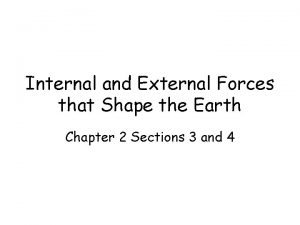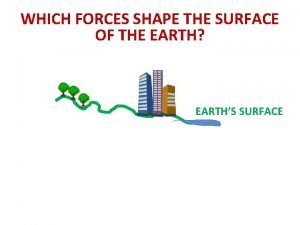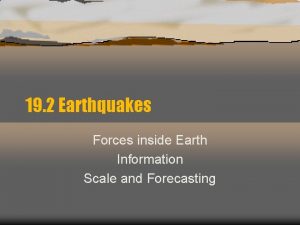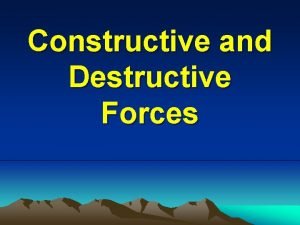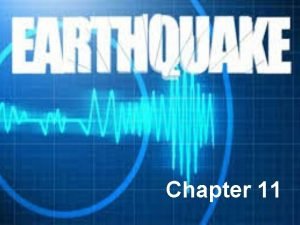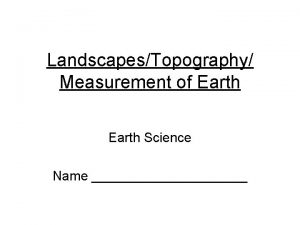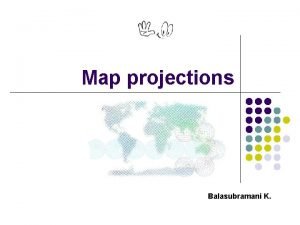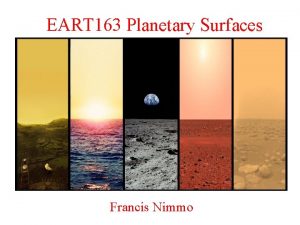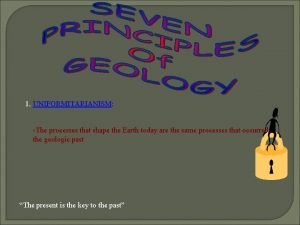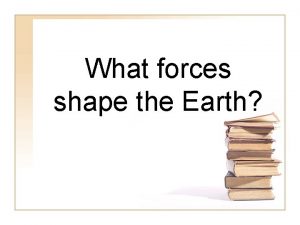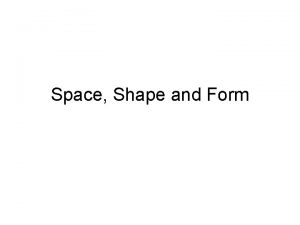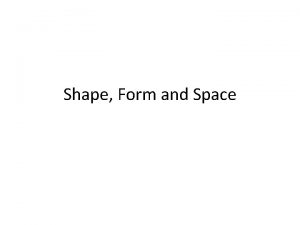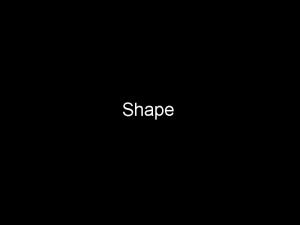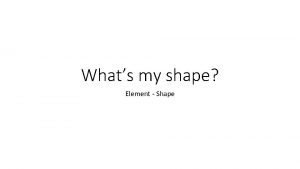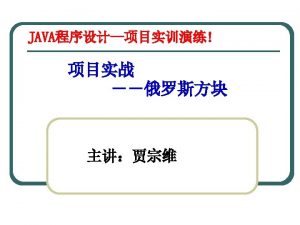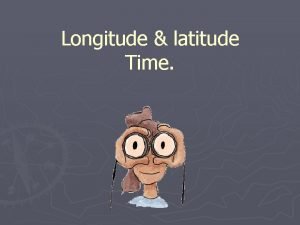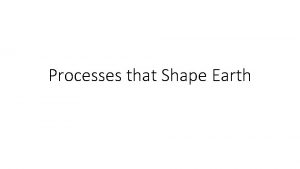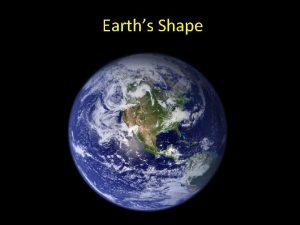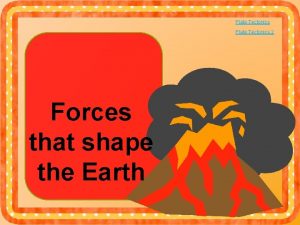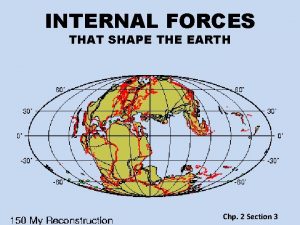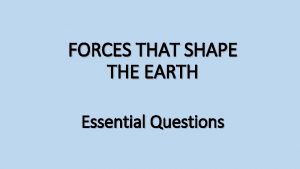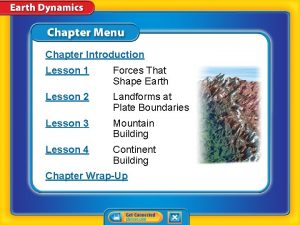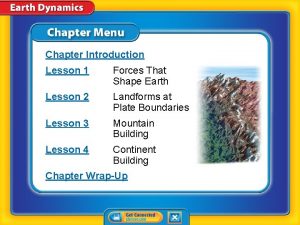FORCES THAT SHAPE THE EARTH Forces that Shape










































- Slides: 42

FORCES THAT SHAPE THE EARTH

Forces that Shape Earth

Continental crust constantly changes over time due to plate tectonics. Forces at plate boundaries are strong enough to break rocks or change their shape.

Stress Force that acts on rock to change its shape or volume Three different kinds of stress can occur in the crust: • Tension • Compression • Shearing

Tension Pulls on the crust, stretching rock so it becomes thinner in the middle Landforms Created by Tension • Mid-ocean ridges – tension causes oceanic crust to spread allowing hot rock from mantle to rise creating high ridges • Continental rifts – when divergent boundaries occur within a continent, they cause enormous splits in the crust

Compression Squeezes rock until it folds or breaks Landforms Created by Compression • Mountain ranges – collision between two continental plates • Ocean trenches – one plate goes under another during collision forming a deep trench where the two plates meet • Volcanic arcs – curved line of volcanoes that forms parallel to plate boundaries

Shearing Pushes a mass of rock in two opposite directions Landforms Created by Shearing • Transform faults – when plates slide horizontally past each other they form a fault, or a break in the rock of the crust • Fault zones – an area of many fractured pieces of crust along a large fault

Strain – a change in the shape of a rock caused by stress • Elastic strain – change in rock that is NOT permanent; when stress is removed rock goes back to original shape • Plastic strain – creates a permanent change in the shape of a rock; usually occurs when rocks are weak or hot

Earthquakes

Earthquake Vibrations in the ground that result from movement along faults, or breaks in Earth’s lithosphere Three types of faults • normal • strike-slip • reverse

Normal Fault Form when forces pull rocks apart along a divergent plate boundary; block of rock above fault moves down

Strike-slip Fault Two blocks of rock slide horizontally past each other in opposite directions

Reverse Fault Force pushes two blocks of rock together with the rock above the fault moving up

Seismic Waves that carry energy of an earthquake away from the focus – point beneath Earth’s surface where rock under stress breaks to cause an earthquake epicenter, or point on the surface directly above the focus

Three types of Seismic Waves • Primary waves (P waves) – compression waves that travel through solids and liquids, compressing and expanding the material they pass through, temporarily changing volume • Secondary waves (S waves) – only travel through solids and temporarily change the shape, but not the volume of the material they pass through; move slower than P waves • Surface waves – move slower than P and S waves, but can produce severe ground movement with a wavelike motion


Locating an Earthquake’s Epicenter Done using triangulating data from at least three different seismometers, or devices that measure and record ground motion and helps determine the distance seismic waves travel.

Steps to Locating an Earthquake’s Epicenter • 1. Find the arrival time difference between the first P-wave and S-wave which is called lag time. • 2. Find the distance to the epicenter by using a graph of lag time vs. distance, then go from yaxis to line and read down to x-axis • 3. Locate the epicenter by using a map scale to mark radius on a compass then draw a circle around each seismometer location to find intersecting point.

Volcanoes

Volcano Weak spot in earth’s crust where molten material, or magma, comes to the surface magma – molten mixture of rock-forming substances, gases and water from the mantle; when magma reaches Earth’s surface it is called lava

At plate boundaries the crust often fractures due to the diverging (pulling) or converging (pushing) plates. As a result, these fractures allow magma to reach the surface forming volcanic belts along the boundaries of Earth’s plates.

Ring of Fire Major belt is the Ring of Fire, formed by many volcanoes that rim the Pacific Ocean.

island arc – string of islands created by volcanoes near boundaries where two oceanic plates collide and one sinks beneath the other hot spot – area where material from deep within the mantle rises then melts, forming magma; a volcano forms above a hot spot when magma erupts through the crust (ex. Hawaiian Islands)

Inside a volcano is a system of passageways through which magma moves. This system includes a magma chamber, pipe, vent, lava flows and a crater vent magma chamber pipe

Geologists classify volcanic eruptions as quiet or explosive: quiet eruption – magma has low silica content, flows easily and erupts quietly with gases bubbling out gently and lava oozing quietly producing both pahoehoe (fast moving hot lava) and aa (lava that is cooler and slower-moving) explosive eruption – has magma high in silica with trapped gases building up pressure until they explode with incredible force creating a pyroclastic flow, or an eruption that hurls out ash, cinders and magma bombs.

dormant volcano – not active, but may become active extinct volcano – unlikely to erupt again

Volcanic Landforms

Landforms from Lava and Ash





Landforms From Magma 1. Volcanic necks – forms when magma hardens in a volcano’s pipe; softer rock around pipe wears away exposing hard rock

Landforms From Magma 2. Dikes – formed when magma forces itself across rock layers and hardens

Landforms From Magma 3. Sill – formed when magma squeezes between horizontal layers of rock

Landforms From Magma 4. Batholiths – mass of rock formed when a large body of magma cools inside the crust

Landforms From Magma 5. Dome mountain – forms when an uplift pushes a batholith or smaller body of hardened magma toward the surface

Geothermal Activity Occurs when magma, a few kilometers, beneath Earth’s surface, heats underground water and forms: • Hot springs • Geysers

Hot Springs Formed when groundwater is heated by a nearby body of magma or hot rock and eventually rises to the surface to collect in a natural pool.

Geyser Fountain of water and steam that erupts from the ground when buildup of pressure is released.

Geothermal Energy Water heated by magma can provide an energy source called geothermal energy which can heat homes and make electricity.

Copyright Information © 2015 Erica L Colón: Nitty Gritty Science, LLC. All rights reserved by the author. My terms for use for all products available are as follows: Purchase of this unit entitles the purchaser the right to reproduce the pages in limited quantities for classroom use only. Duplication for an entire school, an entire school system, or commercial purposes is strictly forbidden without written permission from the author: Erica Colón: Nitty. Gritty. Science@gmail. com or by purchasing multiple licenses. Copying any part of this product and placing it on the internet in any form (even a personal/classroom website) is strictly forbidden and is a violation of the Digital Millennium Copyright Act (DMCA). You may post pictures from using this product in your classroom as long as you provide a link back to my store.
 External forces of the earth
External forces of the earth External forces that shape the earth
External forces that shape the earth Chiến lược kinh doanh quốc tế của walmart
Chiến lược kinh doanh quốc tế của walmart Gây tê cơ vuông thắt lưng
Gây tê cơ vuông thắt lưng Block nhĩ thất độ 3
Block nhĩ thất độ 3 Tìm độ lớn thật của tam giác abc
Tìm độ lớn thật của tam giác abc Sau thất bại ở hồ điển triệt
Sau thất bại ở hồ điển triệt Thơ thất ngôn tứ tuyệt đường luật
Thơ thất ngôn tứ tuyệt đường luật Con hãy đưa tay khi thấy người vấp ngã
Con hãy đưa tay khi thấy người vấp ngã Thơ thất ngôn tứ tuyệt đường luật
Thơ thất ngôn tứ tuyệt đường luật Tôn thất thuyết là ai
Tôn thất thuyết là ai Phân độ lown
Phân độ lown Forces inside earth
Forces inside earth What is constructive forces
What is constructive forces Forces inside earth
Forces inside earth Centripetal drainage pattern
Centripetal drainage pattern Actual shape of earth
Actual shape of earth The shape of the earth
The shape of the earth Shape of the earth
Shape of the earth Describe the true shape of earth's orbit
Describe the true shape of earth's orbit Lateral continuity
Lateral continuity Gấu đi như thế nào
Gấu đi như thế nào ưu thế lai là gì
ưu thế lai là gì Tư thế ngồi viết
Tư thế ngồi viết Bàn tay mà dây bẩn
Bàn tay mà dây bẩn Thế nào là hệ số cao nhất
Thế nào là hệ số cao nhất Trời xanh đây là của chúng ta thể thơ
Trời xanh đây là của chúng ta thể thơ Frameset trong html5
Frameset trong html5 Tư thế ngồi viết
Tư thế ngồi viết V. c c
V. c c Thẻ vin
Thẻ vin Các châu lục và đại dương trên thế giới
Các châu lục và đại dương trên thế giới Tư thế worm breton là gì
Tư thế worm breton là gì Hươu thường đẻ mỗi lứa mấy con
Hươu thường đẻ mỗi lứa mấy con Từ ngữ thể hiện lòng nhân hậu
Từ ngữ thể hiện lòng nhân hậu Diễn thế sinh thái là
Diễn thế sinh thái là Vẽ hình chiếu vuông góc của vật thể sau
Vẽ hình chiếu vuông góc của vật thể sau Mật thư tọa độ 5x5
Mật thư tọa độ 5x5 Bổ thể
Bổ thể Lời thề hippocrates
Lời thề hippocrates Vẽ hình chiếu đứng bằng cạnh của vật thể
Vẽ hình chiếu đứng bằng cạnh của vật thể đại từ thay thế
đại từ thay thế Quá trình desamine hóa có thể tạo ra
Quá trình desamine hóa có thể tạo ra
